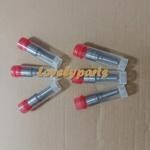Information injection-pump assembly
BOSCH
9 400 613 158
9400613158
ZEXEL
101608-1960
1016081960
MITSUBISHI
ME170448
me170448
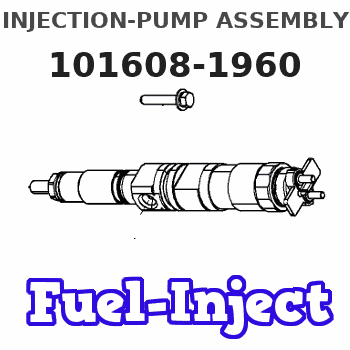
Rating:
Service parts 101608-1960 INJECTION-PUMP ASSEMBLY:
1.
_
6.
COUPLING PLATE
7.
COUPLING PLATE
8.
_
9.
_
11.
Nozzle and Holder
ME075761
12.
Open Pre:MPa(Kqf/cm2)
15.7(160)/21.6(220)
14.
NOZZLE
Include in #1:
101608-1960
as INJECTION-PUMP ASSEMBLY
Include in #2:
104746-5831
as _
Cross reference number
BOSCH
9 400 613 158
9400613158
ZEXEL
101608-1960
1016081960
MITSUBISHI
ME170448
me170448
Zexel num
Bosch num
Firm num
Name
101608-1960
9 400 613 158
ME170448 MITSUBISHI
INJECTION-PUMP ASSEMBLY
6D17-2 K 14BF INJECTION PUMP ASSY PE6AD PE
6D17-2 K 14BF INJECTION PUMP ASSY PE6AD PE
Calibration Data:
Adjustment conditions
Test oil
1404 Test oil ISO4113 or {SAEJ967d}
1404 Test oil ISO4113 or {SAEJ967d}
Test oil temperature
degC
40
40
45
Nozzle and nozzle holder
105780-8140
Bosch type code
EF8511/9A
Nozzle
105780-0000
Bosch type code
DN12SD12T
Nozzle holder
105780-2080
Bosch type code
EF8511/9
Opening pressure
MPa
17.2
Opening pressure
kgf/cm2
175
Injection pipe
Outer diameter - inner diameter - length (mm) mm 6-2-600
Outer diameter - inner diameter - length (mm) mm 6-2-600
Overflow valve
131424-8420
Overflow valve opening pressure
kPa
255
221
289
Overflow valve opening pressure
kgf/cm2
2.6
2.25
2.95
Tester oil delivery pressure
kPa
157
157
157
Tester oil delivery pressure
kgf/cm2
1.6
1.6
1.6
Direction of rotation (viewed from drive side)
Left L
Left L
Injection timing adjustment
Direction of rotation (viewed from drive side)
Left L
Left L
Injection order
1-5-3-6-
2-4
Pre-stroke
mm
3.2
3.15
3.25
Beginning of injection position
Governor side NO.1
Governor side NO.1
Difference between angles 1
Cal 1-5 deg. 60 59.5 60.5
Cal 1-5 deg. 60 59.5 60.5
Difference between angles 2
Cal 1-3 deg. 120 119.5 120.5
Cal 1-3 deg. 120 119.5 120.5
Difference between angles 3
Cal 1-6 deg. 180 179.5 180.5
Cal 1-6 deg. 180 179.5 180.5
Difference between angles 4
Cyl.1-2 deg. 240 239.5 240.5
Cyl.1-2 deg. 240 239.5 240.5
Difference between angles 5
Cal 1-4 deg. 300 299.5 300.5
Cal 1-4 deg. 300 299.5 300.5
Injection quantity adjustment
Adjusting point
-
Rack position
11.9
Pump speed
r/min
850
850
850
Each cylinder's injection qty
mm3/st.
81.5
79.1
83.9
Basic
*
Fixing the rack
*
Standard for adjustment of the maximum variation between cylinders
*
Injection quantity adjustment_02
Adjusting point
Z
Rack position
9.5+-0.5
Pump speed
r/min
600
600
600
Each cylinder's injection qty
mm3/st.
10.8
9.2
12.4
Fixing the rack
*
Standard for adjustment of the maximum variation between cylinders
*
Injection quantity adjustment_03
Adjusting point
A
Rack position
R1(11.9)
Pump speed
r/min
850
850
850
Average injection quantity
mm3/st.
81.5
80.5
82.5
Basic
*
Fixing the lever
*
Injection quantity adjustment_04
Adjusting point
B
Rack position
(R1+0.35
)
Pump speed
r/min
1450
1450
1450
Average injection quantity
mm3/st.
88
84
92
Fixing the lever
*
Injection quantity adjustment_05
Adjusting point
C
Rack position
R1-0.5
Pump speed
r/min
500
500
500
Average injection quantity
mm3/st.
59.5
55.5
63.5
Fixing the lever
*
Injection quantity adjustment_06
Adjusting point
I
Rack position
-
Pump speed
r/min
100
100
100
Average injection quantity
mm3/st.
95
85
105
Fixing the lever
*
Rack limit
*
Timer adjustment
Pump speed
r/min
1150--
Advance angle
deg.
0
0
0
Remarks
Start
Start
Timer adjustment_02
Pump speed
r/min
1100
Advance angle
deg.
0.5
Timer adjustment_03
Pump speed
r/min
1450
Advance angle
deg.
5
4.5
5.5
Remarks
Finish
Finish
Test data Ex:
Governor adjustment
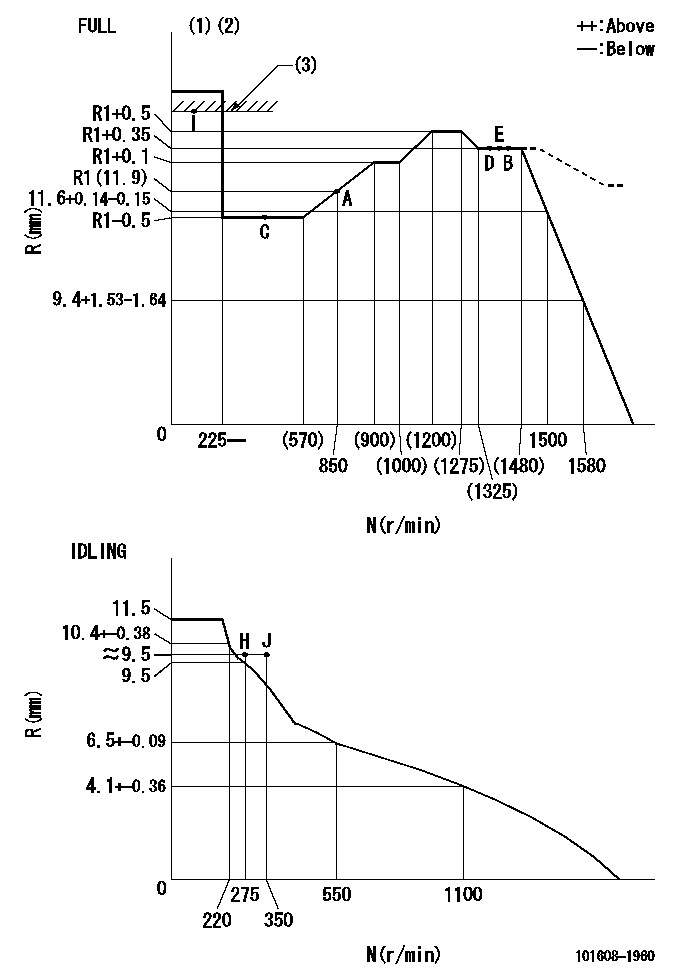
N:Pump speed
R:Rack position (mm)
(1)Torque cam stamping: T1
(2)Tolerance for racks not indicated: +-0.05mm.
(3)RACK LIMIT
----------
T1=L01
----------
----------
T1=L01
----------
Speed control lever angle
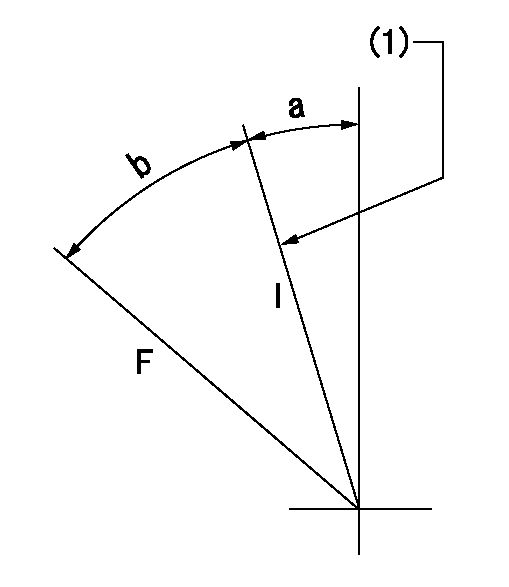
F:Full speed
I:Idle
(1)Stopper bolt set position 'H'
----------
----------
a=18.5deg+-5deg b=39deg+-3deg
----------
----------
a=18.5deg+-5deg b=39deg+-3deg
Stop lever angle
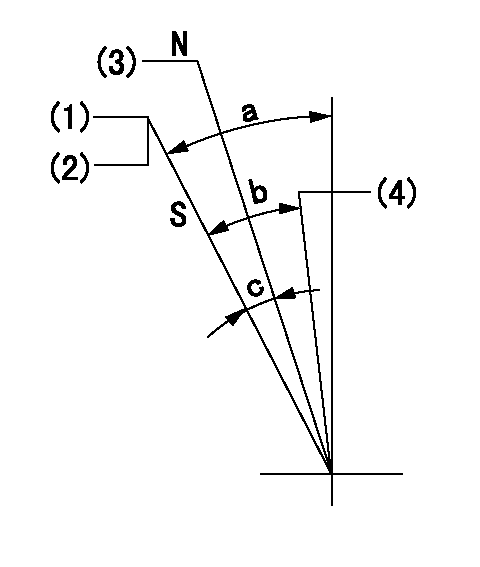
N:Engine manufacturer's normal use
S:Stop the pump.
(1)Set the stopper bolt at pump speed = aa and rack position = bb (non-injection rack position). Confirm non-injection.
(2)After setting the stopper bolt, confirm non-injection at speed cc. Rack position = dd (non-injection rack position).
(3)Rack position = approximately ee (speed lever full, speed = ff).
(4)Free (at delivery)
----------
aa=1450r/min bb=7.2-0.5mm cc=275r/min dd=(8.8)mm ee=15mm ff=0r/min
----------
a=36.5deg+-5deg b=(25deg) c=13deg+-5deg
----------
aa=1450r/min bb=7.2-0.5mm cc=275r/min dd=(8.8)mm ee=15mm ff=0r/min
----------
a=36.5deg+-5deg b=(25deg) c=13deg+-5deg
0000001501 LEVER
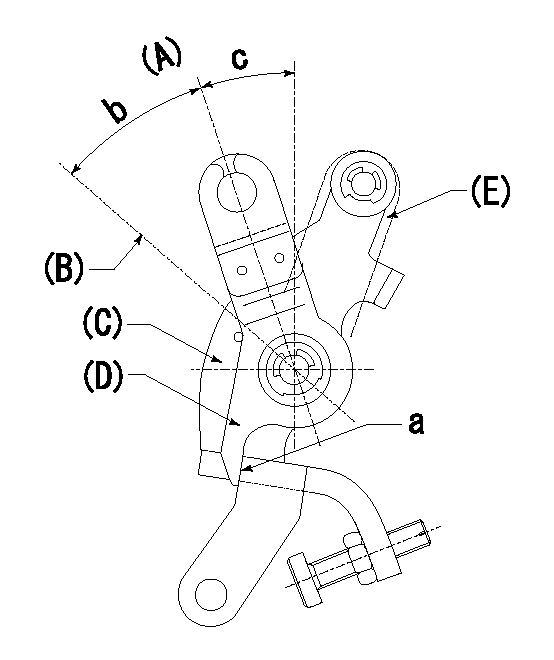
(A) Idle
(B) Full speed
(C) Base lever
(D) Accelerator lever
(E) Accelerator lever delivery position
1. Measure speed lever angle
(1)Measure the angle when the accelerator lever (D) contacted the base lever (C) at a.
----------
----------
b=39deg+-3deg c=18.5deg+-5deg
----------
----------
b=39deg+-3deg c=18.5deg+-5deg
Timing setting

(1)Pump vertical direction
(2)Position of timer's tooth at No 1 cylinder's beginning of injection
(3)B.T.D.C.: aa
(4)-
----------
aa=7deg
----------
a=(4deg)
----------
aa=7deg
----------
a=(4deg)
Information:
Maintenance
Every 20,000 miles (30,000 km) or 1,000 hours, clean the oil drain pipe from turbocharger to sump, also turbocharger compressor wheel and cover.
T1Remove the air inlet duct and compressor housing and check for dirt or dust build-up (see Fig. T.1).Remove all foreign matter - determine and correct cause of build up.Use soft brush on compressor wheel as uneven deposits can affect rotor balance and cause bearing failure.With the compressor housing removed, push the compressor wheel towards the turbine wheel and turn rotating assembly by hand: check for binding and rubbing. Listen carefully for unusual noises. If binding or rubbing is evident, remove the turbocharger for dismantling and inspection.To Remove Turbocharger
Disconnect turbocharger inlet and outlet connections.Disconnect exhaust pipe.Remove oil supply pipe and release oil drain pipe.Release turbocharger outlet assembly from the cylinder block.
T2Remove turbocharger from exhaust manifold, (see Fig. T.2).Seal open engine connections.Airesearch T-31 (see Fig. T.3)
T3Dismantling
Clean the exterior with a pressure spray of a non-caustic cleaning solvent before dismantling. Dismantle only as required to make necessary inspection or repairs. Note: The 'Wastegate' unit where fitted, cannot be dismantled. See page T.4 for service/calibration instructions. As each part is removed, place in a clean container to prevent loss or damage.Remove the bolts, clamps and lockplates which hold the compressor and turbine housings to the centre housing group. Tap the housings with a soft faced hammer if force is needed for removal. Exercise caution when removing housings to prevent damage to compressor or turbine wheel. Once damaged, they cannot be repaired. Never attempt to straighten bent compressor or turbine blades-replace the faulty component.Place the centre housing group in a suitable holding fixture which will prevent the turbine wheel from turning.Use a T-handled wrench when removing the compressor wheel locknut to avoid possible bending of the shaft.Lift the compressor wheel off the shaft. Remove the shaft wheel from the centre housing keeping shaft central with bearings until clear of centre housing. The turbine wheel shroud is not retained to the centre housing and will fall free when the shaft wheel is removed.Remove lockplates and bolts from back plate.Tap backplate with soft mallet to remove from recess in centre housing.Remove thrust collar and thrust bearing from centre housing.Remove bearings and retainers from centre housing. Discard rubber sealing ring.Cleaning
Before cleaning, inspect all parts for signs of rubbing, burning or other damage which might not be evident after cleaning.Soak all parts in clean non-caustic carbon solvent. After soaking, use a stiff bristle brush and remove all dirt particles. Dry parts thoroughly. Normally a light accumulation of carbon deposits will not affect turbine operation.Internal Parts Inspection (see Fig. T.4)
T4Parts must now show signs of damage, corrosion or deterioration. Threads must not be nicked, crossed or stripped.The turbine wheel must show no signs of rubbing and vanes must not be torn or worn to a feather edge. The shaft must show little signs of scoring, scratches or seizure with the bearings.The compressor must show no signs of rubbing or damage from foreign matter. The compressor wheel
Every 20,000 miles (30,000 km) or 1,000 hours, clean the oil drain pipe from turbocharger to sump, also turbocharger compressor wheel and cover.
T1Remove the air inlet duct and compressor housing and check for dirt or dust build-up (see Fig. T.1).Remove all foreign matter - determine and correct cause of build up.Use soft brush on compressor wheel as uneven deposits can affect rotor balance and cause bearing failure.With the compressor housing removed, push the compressor wheel towards the turbine wheel and turn rotating assembly by hand: check for binding and rubbing. Listen carefully for unusual noises. If binding or rubbing is evident, remove the turbocharger for dismantling and inspection.To Remove Turbocharger
Disconnect turbocharger inlet and outlet connections.Disconnect exhaust pipe.Remove oil supply pipe and release oil drain pipe.Release turbocharger outlet assembly from the cylinder block.
T2Remove turbocharger from exhaust manifold, (see Fig. T.2).Seal open engine connections.Airesearch T-31 (see Fig. T.3)
T3Dismantling
Clean the exterior with a pressure spray of a non-caustic cleaning solvent before dismantling. Dismantle only as required to make necessary inspection or repairs. Note: The 'Wastegate' unit where fitted, cannot be dismantled. See page T.4 for service/calibration instructions. As each part is removed, place in a clean container to prevent loss or damage.Remove the bolts, clamps and lockplates which hold the compressor and turbine housings to the centre housing group. Tap the housings with a soft faced hammer if force is needed for removal. Exercise caution when removing housings to prevent damage to compressor or turbine wheel. Once damaged, they cannot be repaired. Never attempt to straighten bent compressor or turbine blades-replace the faulty component.Place the centre housing group in a suitable holding fixture which will prevent the turbine wheel from turning.Use a T-handled wrench when removing the compressor wheel locknut to avoid possible bending of the shaft.Lift the compressor wheel off the shaft. Remove the shaft wheel from the centre housing keeping shaft central with bearings until clear of centre housing. The turbine wheel shroud is not retained to the centre housing and will fall free when the shaft wheel is removed.Remove lockplates and bolts from back plate.Tap backplate with soft mallet to remove from recess in centre housing.Remove thrust collar and thrust bearing from centre housing.Remove bearings and retainers from centre housing. Discard rubber sealing ring.Cleaning
Before cleaning, inspect all parts for signs of rubbing, burning or other damage which might not be evident after cleaning.Soak all parts in clean non-caustic carbon solvent. After soaking, use a stiff bristle brush and remove all dirt particles. Dry parts thoroughly. Normally a light accumulation of carbon deposits will not affect turbine operation.Internal Parts Inspection (see Fig. T.4)
T4Parts must now show signs of damage, corrosion or deterioration. Threads must not be nicked, crossed or stripped.The turbine wheel must show no signs of rubbing and vanes must not be torn or worn to a feather edge. The shaft must show little signs of scoring, scratches or seizure with the bearings.The compressor must show no signs of rubbing or damage from foreign matter. The compressor wheel
Have questions with 101608-1960?
Group cross 101608-1960 ZEXEL
Mitsubishi
101608-1960
9 400 613 158
ME170448
INJECTION-PUMP ASSEMBLY
6D17-2
6D17-2
